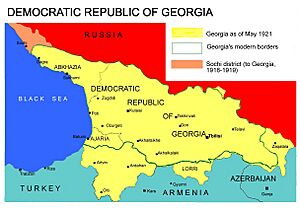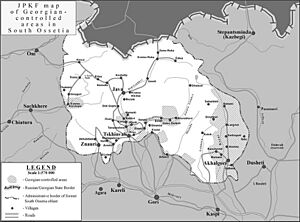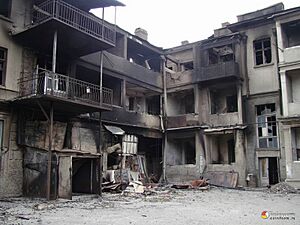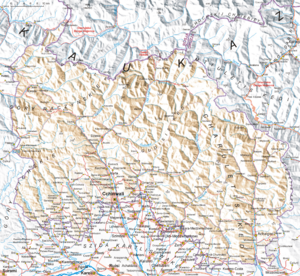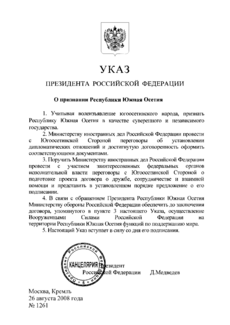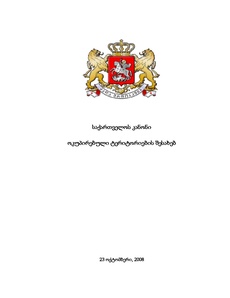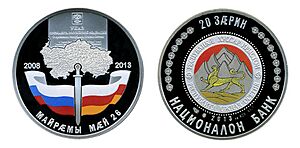South Ossetia facts for kids
Quick facts for kids
Republic of South Ossetia
or the State of Alania (official names are equivalent) Official names
|
|||||||
|---|---|---|---|---|---|---|---|
|
Anthem: "Республикӕ Хуссар Ирыстоны Паддзахадон гимн" (Ossetian)
(English: "National Anthem of the Republic of South Ossetia") |
|||||||

South Ossetia in dark green, with Georgia in dark grey
|
|||||||
| Status | Partially recognised state | ||||||
| Capital and largest city
|
Tskhinvali 42°13′30″N 43°58′12″E / 42.22500°N 43.97000°E |
||||||
| Official languages |
|
||||||
| Ethnic groups
(2015)
|
|||||||
| Government | Unitary semi-presidential republic | ||||||
| Alan Gagloev | |||||||
| Konstantin Dzhussoev | |||||||
| Legislature | Parliament | ||||||
| Independence from Georgia | |||||||
|
• As the South Ossetian Soviet Democratic Republic
|
20 September 1990 | ||||||
|
• As the Republic of South Ossetia
|
21 December 1991 | ||||||
| Area | |||||||
|
• Total
|
3,885 km2 (1,500 sq mi) | ||||||
|
• Water (%)
|
negligible | ||||||
| Population | |||||||
|
• 2022 estimate
|
56,520 | ||||||
|
• 2015 census
|
53,532 (212th) | ||||||
|
• Density
|
13.7/km2 (35.5/sq mi) | ||||||
| GDP (nominal) | 2021 estimate | ||||||
|
• Total
|
$52 million | ||||||
|
• Per capita
|
$1,000 | ||||||
| Currency | Russian ruble (RUB) | ||||||
| Time zone | UTC+03:00 (MSK) | ||||||
| Driving side | right | ||||||
| Calling code | +7 929 | ||||||
South Ossetia ( O-set-EE-ə), officially called the Republic of South Ossetia or the State of Alania, is a landlocked area in the South Caucasus. It is a partially recognised state, meaning only a few countries see it as an independent nation.
As of 2024, only five countries that are part of the United Nations (UN) recognise South Ossetia as its own state. These are Russia, Venezuela, Nicaragua, Nauru, and Syria. Most other countries, including Georgia, consider South Ossetia to be part of Georgia's territory.
The way South Ossetia is governed is a big part of the Georgian–Ossetian conflict and Georgia–Russia relations. The Georgian government calls the area the "Tskhinvali region" and sees it as part of Georgia. Since Georgia does not control the area, it has a special group called the Provisional Administration of South Ossetia.
South Ossetia used to be an "autonomous oblast" (a special region) within the Georgian Soviet Socialist Republic. It declared its independence in 1990. This led to a war in 1991–1992. After this war, the conflict was "frozen," meaning it was not active but also not solved. There were more conflicts in 2004 and 2008. The 2008 conflict led to the Russo-Georgian War. After this war, Ossetian and Russian forces took control of the area. Many countries now see South Ossetia as land occupied by the Russian military.
South Ossetia gets a lot of help from Russia, including military, political, and financial support. Since 2008, leaders in South Ossetia have said they want to join Russia. If this happens, South Ossetia would no longer be an independent state.
Contents
A Look at History
Early History and Migrations
The Ossetians are thought to be descendants of the Alans, a group of nomadic people from ancient times. In the 8th century, a kingdom called Alania formed in the northern Caucasus Mountains. Around the 1200s, the Mongols and later Timur's armies attacked Alania. Many Alans were killed, and the survivors moved into the mountains.
They slowly started moving south, crossing the Caucasus Mountains into the Kingdom of Georgia. In the 17th century, more Ossetians moved from the North Caucasus to the Kingdom of Kartli in Georgia. Georgian kings allowed them to settle there. By the late 1700s, many Ossetians lived in areas that are now part of South Ossetia.
In 1801, the Russian Empire took over the Georgian Kingdom of Kartli-Kakheti, which included modern South Ossetia. Ossetian migration into Georgian areas continued into the 19th and 20th centuries.
South Ossetia in the Soviet Union
After the October Revolution in Russia, modern South Ossetia became part of the Democratic Republic of Georgia. From 1918 to 1920, there was conflict between Ossetian farmers and the Georgian government. The Ossetians wanted land, and the conflict soon became about ethnic differences. The Soviet Union secretly supported the Ossetian rebels.
After the Red Army invasion of Georgia in 1921, the Soviet Georgian government created the South Ossetian Autonomous Oblast (AO) in April 1922. This was a special region for Ossetians in the South Caucasus. Some people believe this autonomy was given to the Ossetians because they supported the Bolsheviks against Georgia. The city of Tskhinvali, which did not have a majority of Ossetians, became the capital of this new region. Many Georgian villages were also included in the South Ossetian AO.
During Soviet times, Ossetians in Georgia had some cultural freedom. They could speak and learn the Ossetian language in schools. However, Russian and Georgian were the official languages.
Georgian-Ossetian Conflict
Rising Tensions (1989–2008)
Tensions grew in the region starting in 1989. This happened as feelings of nationalism became stronger among both Georgians and Ossetians. Before this, people from both groups in the South Ossetian AO had generally lived peacefully together. There were even many marriages between Georgians and Ossetians.
A big part of the conflict was about how long Ossetians had lived in the South Caucasus. Georgian historians say Ossetians mostly moved there in the 17th century. But Ossetians say they have been there since ancient times.
In 1989, the South Ossetian regional council asked to become an "autonomous republic." This made the conflict worse. Georgia's parliament then canceled South Ossetia's special status in December 1990. The Georgian president at the time, Zviad Gamsakhurdia, said Ossetians were "newcomers" and had no right to a state in Georgia.
Troops from Georgia and the Soviet Union were sent to the region. In January 1991, Georgian troops entered Tskhinvali. The 1991–1992 South Ossetia War began. Both sides reported bad actions by militias. The Soviet military helped arrange a ceasefire. Georgia declared its independence in April 1991.
Because of the war, about 100,000 Ossetians left the area and went to North Ossetia. Also, 23,000 Georgians left South Ossetia for other parts of Georgia.
In January 1992, South Ossetia held a vote for independence and to join Russia. Most voters supported these ideas, but other countries did not accept the results. South Ossetia then declared itself the independent Republic of South Ossetia in May 1992.
A ceasefire agreement was signed in June 1992. A peacekeeping force with Ossetians, Russians, and Georgians was set up. From then until 2004, South Ossetia was mostly peaceful.
After the 2003 Rose Revolution in Georgia, Mikheil Saakashvili became president. He promised to bring Georgia's regions back under its control. Tensions rose again in 2004. Georgia tried to stop smuggling through the Roki Tunnel, which was a main source of money for South Ossetia. This led to more violence and fighting.
Georgia also complained about Russia's growing presence in the region. They wanted the peacekeeping force to be more neutral.
The 2008 War
Tensions between Georgia and Russia increased in April 2008. On August 1, 2008, a bomb hit a car carrying Georgian peacekeepers. South Ossetian separatists then started shelling Georgian villages. Georgian troops fired back.
On August 7, 2008, Georgian President Mikheil Saakashvili announced a ceasefire. But attacks on Georgian villages continued. Georgian troops then moved towards Tskhinvali, the capital of South Ossetia, on the night of August 7-8.
Russia accused Georgia of "aggression" and launched a large-scale invasion of Georgia on August 8, 2008. Russian forces quickly took control of Tskhinvali. They also occupied several Georgian cities.
After the war, many Georgian villages around Tskhinvali were destroyed. About 192,000 people were forced to leave their homes. Many returned later, but about 30,000 Georgians remained displaced. The South Ossetian leader said Georgians would not be allowed to return.
A ceasefire was negotiated on August 12, 2008. Russia recognised South Ossetia as an independent republic on August 26. Georgia then broke off diplomatic relations with Russia. Since the war, Georgia and many other countries say that South Ossetia is occupied by the Russian military.
After the 2008 War
In 2016, there was talk of a vote for South Ossetia to join Russia, but it was put on hold. In 2017, a vote was held to officially change South Ossetia's name to "Republic of South Ossetia – State of Alania." Most people supported this change.
In 2022, the South Ossetian president said he wanted to start the process of joining Russia. However, he later lost the election.
Geography and Climate
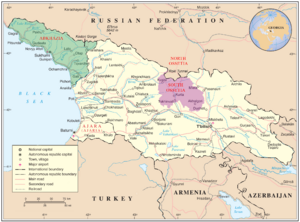
South Ossetia is a very mountainous region. It is located in the Caucasus area, where Asia and Europe meet. It sits on the southern slopes of the Greater Caucasus mountain range.
The Greater Caucasus Mountains form South Ossetia's northern border with Russia. There is only one main road through these mountains, called the TransKAM highway. It goes through the Roki tunnel into North Ossetia. This tunnel was very important for the Russian military during the 2008 war.
South Ossetia covers about 3,900 km2 (1,506 sq mi). More than 89% of the land is over 1,000 m (3,281 ft) above sea level. The highest point is Mount Khalatsa, which is 3,938 m (12,920 ft) high.
Most of South Ossetia is in the Kura River Basin. Major rivers include the Greater and Little Liakhvi, and the Ksani.
Climate of South Ossetia
South Ossetia's climate is influenced by warm air from the East and West. The Greater Caucasus mountains block cold air from the north. This makes the region warmer, even at high altitudes.
The mountains have cool, wet summers and snowy winters. Snow can be over two meters deep in many areas. The wettest times of the year are usually spring and autumn. Winter and summer are generally drier. Higher elevations are much colder. Areas above 2,000 m (6,562 ft) often have frost even in summer.
The average temperature in January is about +4 degrees Celsius. In July, it is around +20.3 degrees Celsius. The region gets about 598 millimeters of rain each year. In general, summer temperatures are 20 °C (68 °F) to 24 °C (75.2 °F). Winter temperatures are 2 °C (35.6 °F) to 4 °C (39.2 °F).
Political Status
After the 2008 South Ossetia war, Russia recognised South Ossetia as independent. However, many Western countries and groups like NATO and the European Council did not agree. They said it went against Georgia's right to control its own land.
Most countries in the United Nations do not recognise South Ossetia as an independent state. South Ossetia held a second vote for independence in 2006. The first vote in 1992 was not recognised by most governments. In the 2006 vote, 99% of voters supported independence. However, this vote was also not recognised by the UN, European Union, or Russia. This was because Georgians living in the area did not take part, and the vote was seen as illegal without Georgia's permission.
In 2007, Georgia created a group called the Provisional Administrative Entity of South Ossetia. This group was led by an Ossetian and aimed to talk with Georgia about the region's future.
South Ossetia, Transnistria, and Abkhazia are sometimes called "frozen conflict" zones. This means the fighting has stopped, but the political problems are still not solved.
Plans to Join Russia
In 2008, some South Ossetian leaders said the region would soon join Russia. They wanted South and North Ossetians to live together in one Russian state. However, the president of South Ossetia at the time, Eduard Kokoity, later said they would not give up their independence.
In 2015, South Ossetia and Russia signed a "alliance and integration" treaty. This agreement said that South Ossetia's military would join Russia's armed forces. It also said Russia would pay salaries for state workers in South Ossetia. Georgia called this agreement an "actual annexation" by Russia. The United States and European Union said they would not recognise it.
In 2015, the South Ossetian president suggested changing the name to South Ossetia–Alania. He also suggested holding a vote to join Russia. This vote was postponed several times. In 2017, a vote was held on the name change, and nearly 80% supported it.
In 2022, the president again said he wanted to start legal steps to join Russia.
Law on Occupied Territories
In 2008, Georgia passed a law about its "occupied territories," which includes South Ossetia. This law limits travel and business in these areas. For example, foreign visitors should only enter South Ossetia through Georgia.
The main road to South Ossetia from Georgia has been closed since 2008. South Ossetian authorities only allow foreigners to enter "through the territory of the Russian Federation."
The Georgian law also says that Russia is responsible for any human rights problems in South Ossetia. It also says that the local governments in South Ossetia are illegal in Georgia's eyes. This law will stay in place until Georgia fully controls these regions again.
Government and Military
How South Ossetia is Governed
South Ossetia has its own government, which acts independently from Georgia. The president is the head of state and leads the government. The president is elected for five years.
South Ossetia's law-making body is the parliament. It has 34 members who are elected for five years. Since May 2022, Alan Gagloev has been the president.
Military Forces
In 2017, parts of South Ossetia's armed forces joined the Russian Armed Forces. Russia has a military base in Tskhinvali, South Ossetia. Russia also has about 20 "militarized border guard bases" near the border with Georgia. These are run by the Russian FSB (security service).
About 3,000–3,500 Russian soldiers are in South Ossetia. Around 1,500 FSB staff are at the border bases. South Ossetian authorities say about 450 of their citizens work at the Russian military base.
In March 2022, the president of South Ossetia said they had sent troops to help Russia in the 2022 Russian invasion of Ukraine. However, about a quarter of these troops left and returned to South Ossetia. The president later said they would not be punished.
People and Culture
Population and Ethnic Groups

2015 census Ossetians (89.94%) Georgians (7.41%) Russians (1.14%) Armenians (0.71%) other (0.81%)
Before the Georgian–Ossetian conflict, about two-thirds of South Ossetia's population were Ossetian. About 25–30% were Georgian. The eastern part of South Ossetia, around Akhalgori, was mostly Georgian. The center and west were mostly Ossetian.
After the 2008 war, many people left their homes. Georgian officials said 15,000 Georgians moved to Georgia. South Ossetian officials said 30,000 Ossetians fled to North Ossetia.
According to a 2015 census by South Ossetian authorities, the total population was 53,532. This included 48,146 Ossetians (89.9%) and 3,966 Georgians (7.4%). Georgian authorities have questioned how accurate these numbers are.
The main religion in South Ossetia is Eastern Orthodoxy. This is practiced by Ossetians, Georgians, and Russians.
Education and Sports
The main university in South Ossetia is South Ossetian State University in Tskhinvali. After the 2008 war, officials tried to send most university students from South Ossetia to Russian colleges.
South Ossetia has a national football team. It is not a member of FIFA or UEFA. The team won the 2019 CONIFA European Football Cup.
Economy
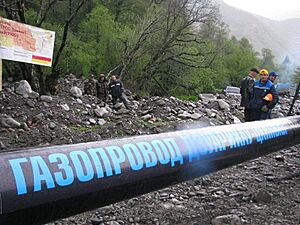
South Ossetia's economy is mostly based on farming. Less than 10% of its land is used for crops. Grains, fruits, and grapes are the main products. There are also forestry and cattle industries. Some factories exist, especially near the capital, Tskhinvali.
After the war in the 1990s, South Ossetia faced economic challenges. Many people survive by farming for themselves. The government has tried to grow more wheat to reduce the need for imported flour.
Before the 2008 war, South Ossetia had 22 small factories. In 2007, only 7 were working. Many factories needed repairs and had too few workers.
One important economic asset for South Ossetia is control of the Roki Tunnel. This tunnel connects Russia and Georgia. The South Ossetian government used to get a lot of money from customs fees on goods passing through it.
Since the 2008 war, South Ossetia's economy relies heavily on money from Russia. By 2010, Russian donations made up almost 99% of South Ossetia's budget. By 2021, this was reduced to 83%. Russia also helps fund development programs in South Ossetia.
Money in South Ossetia
Zarin
One of South Ossetia's official currencies is the Zarin. These are coins and bars that are not used for everyday shopping. They are mostly for collecting and show important events or people from South Ossetian history. They are made of silver or gold.
South Ossetian Ruble
The official currency used for everyday transactions is the South Ossetian ruble. It is similar to the Russian ruble, with the same values. South Ossetia makes its own coins, but it does not print paper money. The South Ossetian ruble is linked to the Russian ruble. It can be used in South Ossetia, Russia, and Abkhazia. However, Russian rubles are used much more often.
Russian Ruble
The Russian ruble is the most common currency used in South Ossetia. It has been used there since South Ossetia declared independence in 1991. Because the South Ossetian ruble is linked to the Russian ruble, people often use them interchangeably. Since South Ossetia does not print its own paper money, people commonly use Russian paper money with South Ossetian coins.
See also
 In Spanish: Osetia del Sur para niños
In Spanish: Osetia del Sur para niños




